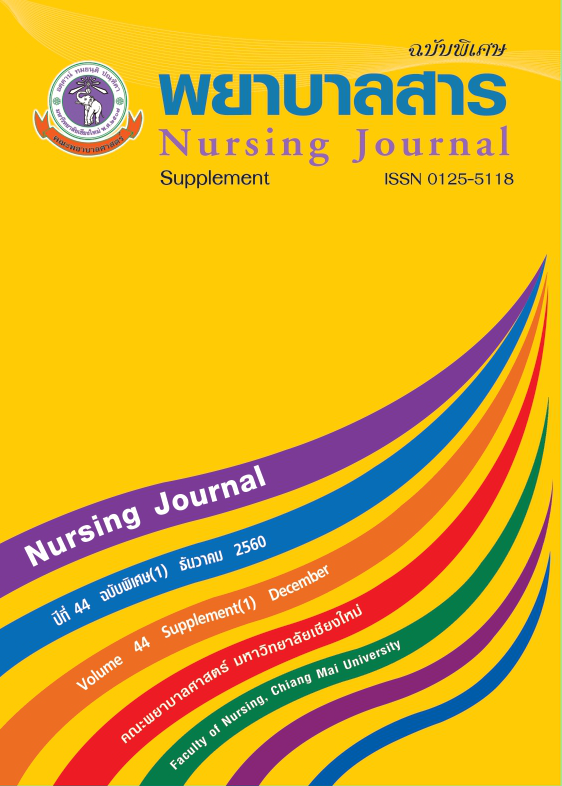Factors Related to Father Involvement Among First Time Expectant Fathers
Keywords:
anxiety, marital relationship, social support, father involvement, first time expectant fathersAbstract
The purpose of this descriptive correlational research study was to explore anxiety, marital relationship, social support and father involvement among first time expectant fathers. The subjects were selected according to inclusion criteria and consisted of 115 first time expectant fathers who took their pregnant wives to the antenatal care unit at Health Promotion Region Center 10, Chiang Mai and Maharaj Nakorn Chiang Mai Hospital from April to June 2015. The research instruments were the Father Involvement of Expectant Father Questionnaire, the State Anxiety Inventory [STAI] form Y-1, the Dyadic Adjustment Scale [DAS], and the Social Support Questionnaire Descriptive statistics and Pearson's product moment correlation were used to analyze the data.
Results of the study revealed that:
- 1. Most participants had moderate anxiety (52.2%) and mild anxiety (47.8%). The mean score for anxiety was 40.59 (S.D. = 7.97).
- 2. Most participants (63.55%) had fairly good marital relationship. The mean score for marital relationship was 3.93 (S.D. = .62).
- 3. Most participants (66.1%) received high social support. The mean score for social support was 3.84 (S.D. = .59).
- 4. Most participants (86.1%) were highly involved during the pregnancy period. The mean score for father involvement was 119.22 (S.D. = 12.57).
- 5. Anxiety had a statistically significant negative correlation with father involvement
(r = -.306, p < .01), while marital relationship had a statistically significant positive correlation with father involvement (r = .678, p < .01) and social support had a statistically significant positive correlation with father involvement (r = .489, p < .01).
The findings from this study can be used as baseline data to promote father involvement during the pregnancy period. It is suggested that further research is done to obtain effective guidelines for nursing care practices for expectant fathers.
References
ตนเองและความคาดหวังผลลัพธ์ที่จะเกิดขึ้นในการดูแลภรรยาขณะตั้งครรภ์ (วิทยานิพนธ์
พยาบาลศาสตรมหาบัณฑิต สาขาการพยาบาลอนามัยชุมชน). บัณฑิตวิทยาลัย, มหาวิทยาลัยสงขลานครินทร์, สงขลา.
กอบกุล พันธ์เจริญวรกุล และเยาวลักษณ์ เสรีเสถียร. (2535). บทบาทของบิดากับการพัฒนาสุขภาพครอบครัว. วารสารสภาการพยาบาล, 7(4), 10 - 14.
ดาราวรรณ ต๊ะปินตา. (2534). การลดความวิตกกังวลของพยาบาลประจำการที่ดูผู้ป่วยโรคเอดส์ด้วยวิธีการปรับเปลี่ยนความคิดร่วมกับการฝึกสติ (วิทยานิพนธ์ปริญญาครุศาสตรดุษฎีบัณฑิต ภาควิชาจิตวิทยา). บัณฑิตวิทยาลัย, จุฬาลงกรณ์มหาวิทยาลัย, กรุงเทพมหานคร.
นิซรีน เจ๊ะมามะ. (2560). ความเครียด การสนับสนุนทางสังคม และการเข้ามามีส่วนร่วมของบิดาในชาวมุสลิมที่กำลังจะเป็นบิดา. พยาบาลสาร, 44(4) (ตุลาคม-ธันวาคม 2560).
ประภัสสร อินทรศักดิ์สิทธิ์. (2540). การมีส่วนร่วมของสามีในการดูแลภรรยาระหว่างตั้งครรภ์และ
คลอด (วิทยานิพนธ์สังคมวิทยามหาบัณฑิต สาขาประชากรศาสตร์ ภาควิชาสังคม
วิทยาและมานุษยวิทยา). บัณฑิตวิทยาลัย, มหาวิทยาลัยจุฬาลงกรณ์ , กรุงเทพมหานคร.
ประภารัตน์ ทวีเกียรติ. (2528). ความสัมพันธ์ระหว่างปัจจัยบางประการกับการรับรู้บทบาทการบิดาของสามีในขณะภรรยาตั้งครรภ์. (วิทยานิพนธ์วิทยาศาสตรมหาบัณฑิต สาขาวิชาพยาบาลศาสตร์). บัณฑิตวิทยาลัย, มหาวิทยาลัยมหิดล. กรุงเทพมหานคร.
เพ็ชรัตน์ ตั้งตระกูลพงศ์. (2546). ปัจจัยสนับสนุนพฤติกรรมของสามีในการส่งเสริมสุขภาพภรรยาขณะตั้งครรภ์ในเขตจังหวัดประจวบคีรีขันธ์. ( วิทยานิพนธ์ศิลปศาสตรมหาบัณฑิต สาขาวิชาจิตวิทยาชุมชน). บัณฑิตวิทยาลัย, มหาวิทยาลัยศิลปากร, กรุงเทพมหานคร.
ศรีเรือน แก้วกังวาล. (2553). จิตวิทยาพัฒนาการชีวิตทุกช่วงวัย วัยรุ่น-วัยสูงอายุ (พิมพ์ครั้งที่ 9) . กรุงเทพมหานคร: สำนักพิมพ์มหาวิทยาลัยธรรมศาสตร์.
Alio, A.P., Lewis, C.A., Scarborough, K., Harris, K., & Fiscella, K. (2013). A community
perspective on the role of fathers during pregnancy: A qualitative study. Biomedcentral Pregnancy and Childbirth, 13(60), 1471-2393.
Cunningham, F., Leveno, K., Bloom, S., Spong, C. Y., & Dashe, J. (2014). Williams Obstetrics (24th ed). New York: McGraw Hill.
Diehl, M., Coyle, N., & Labouvie-Vief, G. (1996). Age and sex difference in strategies of coping and defense across the life span. Psychology and Aging, 11, 127-139.
Dudgeon, M., & Inhorn, M. (2004). Men’s influences on women’s reproductive health: Medical anthropological perspectives. Social Science of Medicine, 59, 1379 - 1395.
Faul, F., Erdfelder, E., Buchner, A., & Lang, A. G. (2009). Statistical power analyses using G* Power 3.1: Tests for correlation and regression analyses.Behavior Research Methods, 41(4), 1149-1160.doi: 10.3758/BRM.41.4.1149
Hausman, C., & Goldring, E. (2000). Parent involvement, influence, and satisfaction in Magnet Schools: Do reasons for choice matter?. The Urban Review, 32(2), 105 - 121. doi: 10.1023/A:1005121214860
Hernandez, D. C., & Coley, R. L. (2007). Measuring father involvement within low-income
families: Who is a reliable and valid reporter? Parenting, 7(1), 69-97. Doi: 10.1080/15295190709336777
Hoffman, J. (2011). Father factors: What social science research tells us about fathers and how to work with them. Retrieved June 25, 2014, from www.fira.ca/cms/documents/211/FatherFactorsFinal.pdf
House, J.S. (1981). Work stress and social support. Mass: Addison - Wesley.
Kalil, A., Ziol‐Guest, K. M., & Coley, R. L. (2005). Perceptions of father involvement patterns in teenage‐mother families: Predictors and links to mothers’ psychological adjustment. Family Relations, 54(2), 197-211.
Lamb, M. E. (2000).The history of research on father involvement. Marriage & Family Review, 29, 23-42. Doi: 10.1300/J002v29n02_03
Lamb, M. E. (1987). Introduction: The emergent American father. In M. E. Lamb (Ed.),The father’s role: Cross-cultural perspectives. New York: Wiley.
Lemonda, C. S. T., Kalman, R. K. , & Yoshikawa, H. (2009). Father involvement in
immigrant and ethnically diverse families from the prenatal period to the second year: Prediction and mediating mechanisms. Springer Science & Business Media, 60, 496 - 509. Doi: 10.1007/s11199-009-9593-3
Lu, M. C., Jones, L., Bond, M. J., Wright, K., Pumpuang, M., Maidenberg, M., ... & Rowley, D. L. (2010). Where is the F in MCH ? Father involvement in African American families. Ethnicity & disease, 20, S2-49
Raojutitham, P. (2006). Marital relationship, attitude toward sex role and paternal involvement in child-rearing of 6-12 month first-born infant. (The degree of master of nursing science maternity and newborn nursing) Faculty of graduate studies, Mahidol University, Thailand
Rhein, L. M., Ginsburg, K. R., Schwarz, D. F., Pinto-Martin, J. A., Zhao, H., Morgan, A. P., & Slap, G. B. (1997). Teen father participation in child rearing: Family perspectives. Journal of Adolescent Health, 21(4), 244-252.
Russel, C. S. (1974). Transition to parenthood: Problems and Gratification. Journal of Marriage and the Family. 36, 294-302.
Sansiriphun, N. (2009). Becoming a first time father among Thais. (Doctoral thesis, Faculty of Nursing, Chiang Mai, Thailand).
Sansiriphun, N., Kantaruksa, K., Klunklin, A., Baosuang, C., & Jordan, P. (2010). Thai men
becoming a first-father. Nursing & Health Sciences, 12(4), 403-409.doi:10.1111/j.1442-2018.2010.00549.x
Spanier, G. B. (1976). Measuring dyadic adjustment: New scale for assessing the quality of marriage and similar dyads. Journal of Marriage and The Family, 35(1), 15-28.
Spielberger, C.D. (1976). The nature and measurement of anxiety. In C.D. Spielberger, & R. Diaz-Guerrero (Eds), Cross-cultural anxiety (pp. 3-12). Washington: Hemisphere.
Spielberger, C.D., Gorsuch, R.L., Lushene, R., Vagg, P.R., & Jacobs, G.A. (1983). Manual for the state-trait anxiety inventory (from Y). New York: Consulting Psychologists.
Downloads
Published
How to Cite
Issue
Section
License
บทความที่ได้รับการตีพิมพ์เป็นลิขสิทธิ์ของวารสารพยาบาลสาร
ข้อความที่ปรากฏในบทความแต่ละเรื่องในวารสารวิชาการเล่มนี้เป็นความคิดเห็นส่วนตัวของผู้เขียนแต่ละท่านไม่เกี่ยวข้องกับมหาวิทยาลัยเชียงใหม่ และคณาจารย์ท่านอื่นๆในมหาวิทยาลัยฯ แต่อย่างใด ความรับผิดชอบองค์ประกอบทั้งหมดของบทความแต่ละเรื่องเป็นของผู้เขียนแต่ละท่าน หากมีความผิดพลาดใด ๆ ผู้เขียนแต่ละท่านจะรับผิดชอบบทความของตนเองแต่ผู้เดียว






